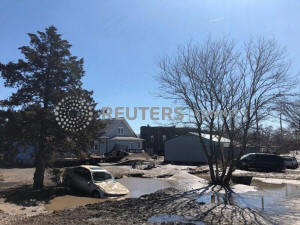|
Missouri River towns face deluge as
floods move downstream
 Send a link to a friend
Send a link to a friend
 [March 21, 2019]
By Humeyra Pamuk [March 21, 2019]
By Humeyra Pamuk
VALLEY, Neb. (Reuters) - A string of small
Missouri towns prepared for the next deluge along the raging Missouri
River on Wednesday after flooding wreaked nearly $1.5 billion in damage
in Nebraska, killing at least four people and leaving another man
missing.
High water unleashed by last week's late-winter storm and melting snow
has already inundated a large swath of Missouri, Nebraska and Iowa along
the Missouri River, North America's longest river. States of emergency
have been declared in all or parts of the three Midwestern farm states.
The Missouri River's next major flood crest was forecast to hit St.
Joseph, Missouri, at 6 a.m. on Friday and Kansas City, Missouri, 55
miles (88 km) to the south, about 24 hours later, said Mike Glasch of
the Omaha District of the U.S. Army Corps of Engineers.
Homeowners and businesses across Leavenworth County, Missouri, where
81,000 people were under a flood warning on Wednesday, were placing
sandbags around property as they have watched the river rise over the
last few days, Kim Buchanan, the county’s deputy director of emergency
management, told Reuters.

"We have moderate flooding at this time," she said, noting that the
forecast shows the river cresting seven feet above flood stage on
Thursday or Friday. "Anybody with river interest has already instigated
their flood plans and have taken their defensive actions.”
FOUR DEAD
The floods killed four people in Nebraska and Iowa since last week, and
officials warned the damage toll would rise as receding waters revealed
more devastated roadways, bridges and homes.
A fifth man has been missing since the collapse of the Spencer Dam along
the Niobrara River last. He was identified by the Omaha World-Herald
newspaper as Kenny Angel.
Authorities said they had rescued nearly 300 people in Nebraska alone.
A levee break prompted the evacuation of the small community of Craig,
Missouri. Real estate agent Jamie Barnes said everyone in town had time
to get out before it was flooded, and water was now flowing south
through farmland toward communities such as Forest City, Forbes and St
Joseph.
"There's just water as far as the eye can see, from bluff to bluff. In
some places its five miles, in some 15," Barnes said by phone.
Several other communities in that area of northwest Missouri have also
been evacuated, the Army Corps of Engineers said at a briefing.
"Much of the levee system remains compromised, and as of noon Wednesday
there are more than 30 total breaches across the system," in the three
states experiencing flooding, Lieutenant Colonel James Startzell, deputy
commander of the U.S. Army Corps of Engineers Omaha District told the
briefing.
AIR FORCE BASE FLOODED
"I was driving out to get one more load of corn from the bins when the
levee broke, and there was a wall of water coming at me," said Howard
Geib, 54, whose farm is near Craig. "I was on the phone with my
son-in-law, who was driving out to help, telling him, 'Stop! Stop! Turn
around!'"
[to top of second column]
|

A vehicle is stuck in mud due to heavy flooding in Winslow,
Nebraska, U.S., March 20, 2019. REUTERS/Humeyra Pamuk

The flooding killed livestock, destroyed grains in storage and cut
off access to farms because of road and rail damage.
Across the Missouri from Craig, the village of Rulo, Nebraska, drew
a small crowd of onlookers to see the deluge, said Kelly Klepper,
owner of Wild Bill’s Bar & Grill.
"We're kind of a tourist attraction right now," Klepper said by
phone.
Missouri emergency managers said they may be spared the worst of the
flooding because of breaches further north.
"It’s really sad that we had a couple levies fail upstream, but
that’s helped everyone downstream,” said Steven Bean of Kansas
City’s emergency management agency.
But Bean said the kind of flooding hitting the Midwest is typically
seen in June and July, after the final snow-melt and the spring
rains.
“This is March, and we haven’t had the final snow melt,” he said.
“We haven’t had the spring rains. The reservoir is full. They have
got to get it empty.”
More than 2,400 Nebraska homes and businesses were destroyed or
damaged, with 200 miles (322 km) of roads unusable and 11 bridges
wiped out, Governor Pete Ricketts said on Wednesday.
Ricketts estimated the floods caused at least $439 million in damage
to public infrastructure and other assets, and $85 million to
privately owned assets. He put flood damage for the state's
agricultural sector at nearly $1 billion.
Offutt Air Force Base near Omaha, which houses the U.S. Strategic
Command, remained heavily flooded, though base officials said on
Twitter the facility was still "mission-capable."
In Valley, Nebraska, outside Omaha, Pete Smock, 42, worked to clear
deep mud surrounding his home and construction business.

"Devastation is everywhere. I haven't seen anything like this in my
lifetime," Smock said. He had rented heavy equipment to fill deep
holes cut by the floods with gravel and repair driveways leading to
his office and garage.
(Reporting by Humeyra Pamuk; Additional reporting by Gina Cherelus
in New York, Rich McKay in Atlanta, Jarrett Renshaw in Philadelphia,
P.J. Huffstutter and Mark Weinraub in Chicago, Brendan O'Brien in
Milwaukee, Andrew Hay in Taos, N.M. and Steve Gorman and Dan
Whitcomb in Los Angeles; Writing by Dan Whitcomb; Editing by Bill
Tarrant and Alistair Bell)
[© 2019 Thomson Reuters. All rights
reserved.]
Copyright 2019 Reuters. All rights reserved. This material may not be published,
broadcast, rewritten or redistributed.
Thompson Reuters is solely responsible for this content. |